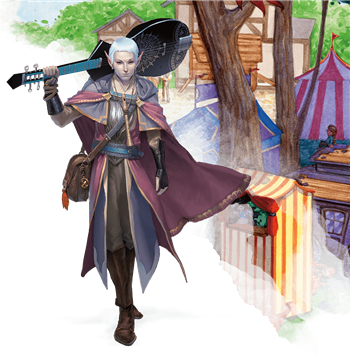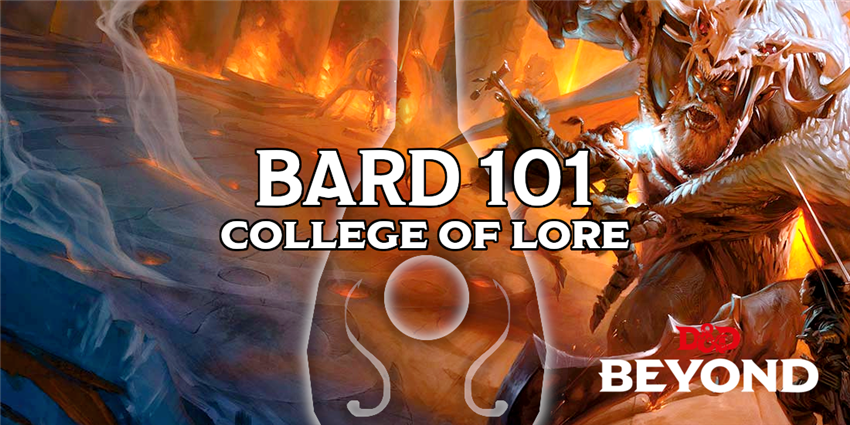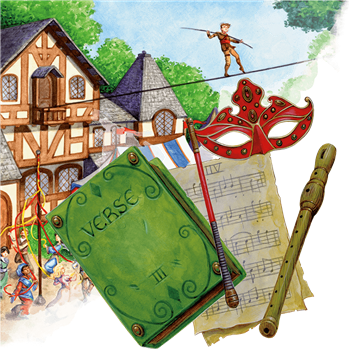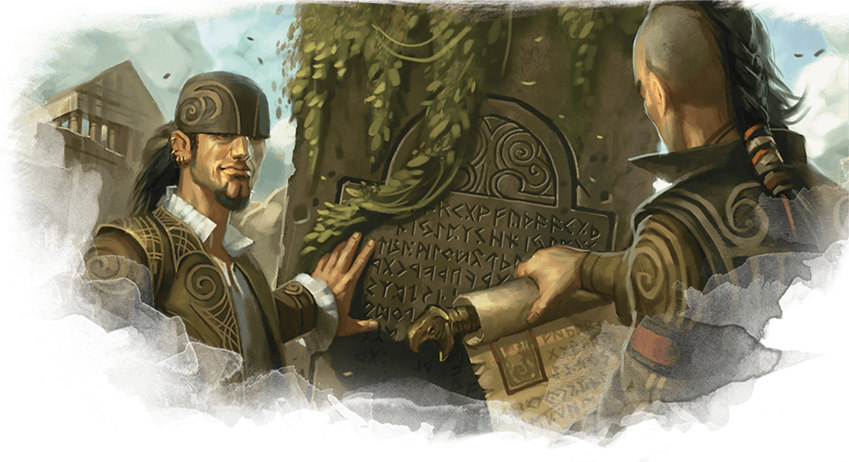Class is back in session, and there’s no learner sharper than bards of the College of Lore. These clever factotums may not be masters of all skills, but they are dabblers that learn skills, spells, and tales from all walks of life. If you’re a bit indecisive and want to be a generalist that supports your party in parts of the game, you can’t go wrong with a bard of the College of Lore.
Story of the College of Lore
 “A tomb of ancient evil lurks in the hills, you say? Tell me everything you know of this so-called Tomb of Horrors.” The bard looked across the barroom table towards a scarred knight in pitted armor, her half-elven fingers steepled and her eyes twinkling. The knight looked toward her and heaved a weighty sigh. He showed her the stump of his arm, and told her of the hideous, devil-faced bas relief he lost his arm to.
“A tomb of ancient evil lurks in the hills, you say? Tell me everything you know of this so-called Tomb of Horrors.” The bard looked across the barroom table towards a scarred knight in pitted armor, her half-elven fingers steepled and her eyes twinkling. The knight looked toward her and heaved a weighty sigh. He showed her the stump of his arm, and told her of the hideous, devil-faced bas relief he lost his arm to.
They spoke long into the night, the knight demonstrating bits of holy magic he had been granted as a member of the order of White Paladins of Hieroneous. She studied the holy words he spoke and the subtle gestures he made with rapt attention, taking notes throughout the evening.
Soon, dawn came. The bard bowed her head, thanked the paladin, and paid for their drinks before bidding him farewell. She exited the tavern and, with a snap of her fingers, replicated the spell the paladin had demonstrated for her. A gleaming, golden-maned warhorse appeared before her in a shower of celestial sparks, and she swung herself upon her newfound steed’s back.
“Thank you, good sir,” she said to herself, as she rode off towards the horizon. “There’s someone back in Greyhawk who’ll pay a pretty penny for what you’ve told me today. And the new spell don’t hurt, neither.”
You are a bard of the College of Lore. Your sharp wit cuts deeper than any blade, and your sharper ears never fail to catch the latest rumors. You may be an erudite collegian, who studies for nights on end in libraries filled with ancient tomes. Or you may be a court jester who learns the latest gossip and skewers haughty courtiers with acerbic repartee.
Whether your bard is an educated loremaster, a rakish gossip, or a swashbuckling, Indiana Jones-type explorer, your expert knowledge is bound to help you on your many adventures. Even though Charisma is your key ability score, consider turning to your other ability scores to inform your personality. A College of Lore bard with a high Intelligence might be more inclined towards academic studies, whereas a bard with high Wisdom might be more streetwise, with a penchant for guile. Likewise, a bard with low Intelligence and Wisdom might simply skate by on savvy, luck, and charm alone, learning tricks only as they suit the bard’s carefully crafted persona.
No matter what story you craft for your bard, there are some things you should know about the traits and features of College of Lore before you commit to playing it. Don’t forget that bards choose their college at 3rd level, so you have some time to get the hang of your character before choosing!

College of Lore Features
The College of Lore is the most iconic bard subclass, representing many different thematic interpretations of the bard, encompassing character types as disparate as the wizened village storyteller and the flamboyant traveling performer. The bard class is already one suited to being a jack-of-all-trades, and joining the College of Lore only broadens the pool of knowledge and talents from which you can choose.
The bard gains three subclass features at 3rd, 6th, and 14th level. You can read all of the College of Lore features for free in the D&D Basic Rules. In summary, your subclass features allow you to:
- Gain proficiency in skills of your choice.
- Distract your foes with your words, weakening the impact of their attacks.
- Gain spells from other classes’ spell lists.
- Use your Bardic Inspiration to enhance your own ability checks.
Benefits of the College of Lore
 Joining the College of Lore transforms already versatile bard into a peerless factotum, allowing you to have a useful tool for almost any occasion. Gaining early access to other classes’ spell lists by means of Additional Magical Secrets (gained at 6th level, in addition to the Magical Secrets which all bards gain at 10th level), allows you to customize your bard to a nigh-limitless degree. If you need an edge in combat, learning wrathful smite from the paladin spell list might be the right choice. If you’ve been dabbling in dark magic, perhaps learning a hex from the warlock spell list is more appropriate.
Joining the College of Lore transforms already versatile bard into a peerless factotum, allowing you to have a useful tool for almost any occasion. Gaining early access to other classes’ spell lists by means of Additional Magical Secrets (gained at 6th level, in addition to the Magical Secrets which all bards gain at 10th level), allows you to customize your bard to a nigh-limitless degree. If you need an edge in combat, learning wrathful smite from the paladin spell list might be the right choice. If you’ve been dabbling in dark magic, perhaps learning a hex from the warlock spell list is more appropriate.
Your Cutting Words feature also improves the versatility of your Bardic Inspiration class feature, allowing you to use Bardic Inspiration reactively as well as proactively. Do note that this feature has no effect on creatures that are immune to being charmed; you can use the D&D Beyond monster finder’s advanced filters to find all monsters that are immune to being charmed, if you want to avoid using your Cutting Words against creatures that can’t be affected by it.
Drawbacks of the College of Lore
First and foremost, the College of Lore’s greatest strength—its versatility—can also be its greatest weakness. If you’re a player who finds yourself paralyzed by decision, or if you’re easily annoyed by choosing which spells to learn each level, this isn’t the subclass for you. Likewise, if you want to be a selfish and self-sufficient warrior, the bard class is largely geared towards aiding the entire party, rather than delivering on huge moments yourself. The College of Lore alleviates this slightly, with its 14th level feature that allows you to spend Bardic Inspiration on your own ability checks, and by allowing you to use Additional Magical Secrets to gain more “selfish” spells, but it’s not enough to turn the bard into a totally self-sufficient warrior.
Suggested Build
If you’re building a College of Lore bard from 1st level, you should choose a race that grants you a bonus to your Charisma score, like tiefling or half-elf. A well-rounded race like human, can help shore up your less-than-stellar physical offense and defense, but as a College of Lore bard, your spells are your first priority.
Because of this, Charisma should be your highest ability score, and Dexterity and Wisdom should be second and third-highest scores, depending on whether you want to be skilled with weapons (Dexterity), or with perceptiveness and social insightfulness (Wisdom).
As usual, your character’s background is up to you. You can play into the theme of being a bardic performer by selecting backgrounds like Entertainer or Charlatan, or into the theme of an academic by choosing a background like Sage or Cloistered Scholar (Sword Coast Adventurers Guide). Or, you could defy theme by having an unusual background like Soldier or Urchin as your background, and use the contrast to tell a surprising and interesting story.
Selecting EQUIPMENT when creating a character is a fine option. Equipment isn’t terribly important to you, since you rely heavily on casting spells. Choose the best armor you can wear, and a finesse weapon like a shortsword or a rapier. Of course, what type of musical instrument you choose is entirely up to your own preference.

Spells
When you choose your spells at 1st level, you'll be getting the hang of what role you want your bard to play in your party. Fortunately, the College of Lore grants you incredible flexibility, so you can take your time figuring out which spells are most useful to you. Unlike some other spellcasting classes, once a bard learns a spell, they know that spell forever. You can "trade out" one known spell for another spell on your spell list when you gain a level, but that's it. You want to have a little bit of everything, and you can pick two cantrips and four 1st-level spells as a 1st-level bard. From there on out, you learn one new bard spell every time you level up (more or less), and can also trade one known spell out, as mentioned above. And that's not even considering the four spells a College of Lore bard will ultimately gain from your two Magical Secrets features. That's a ton of spells, so don't fret too much over the decision.
Since you want a smattering of everything, choose any two cantrips you like (one of them should probably be vicious mockery, since it's so iconic), and four spells from the suggested list below. Try to choose one spell labeled SUPPORT, one labeled DEFENSE, one labeled SOCIAL, and one more of your preference. Note that this list only includes some spells from the Player's Handbook, so if you want to choose more unusual spells, or have other sources like Xanathar's Guide to Everything, you'll have to do a little self-directed research. This list is just here to get you started if this is your first time playing a College of Lore bard.
- Bane (DEFENSE)
- Charm Person (SOCIAL)
- Cure Wounds (SUPPORT)
- Detect Magic (SUPPORT)
- Disguise Self (SOCIAL)
- Dissonant Whispers (OFFENSE)
- Faerie Fire (SUPPORT)
- Tasha’s Hideous Laughter (DEFENSE)
- Silent Image (SOCIAL)
- Thunderwave (OFFENSE)
At Higher Levels
You’ll be able to select the College of Lore as your subclass at 3rd level, and either improve your ability scores or gain a feat at 4th level. When faced with this choice, consider your experiences in the campaign so far; are you constantly being targeted by enemies and having your precious concentration spells broken by damage? If so, you should probably take the War Caster feat, which makes it harder for damage to break your concentration. If not, consider improving your Charisma score, and thus making your spells more potent.
Bard is an excellent class to go “all the way” with, and take levels in it all the way up to 20th level. At the very least, gaining levels in bard as quickly as possible, without slowing down by dabbling in other classes, is your top priority. Every bard level you gain gets you closer to stronger and stronger spells, and you’re already such a skilled jack-of-all-trades that you don’t need to multiclass.
If you want more advice for building a bard, check out Bard 101. Have you ever played a College of Lore bard? What advice would you give to players that want to play this subclass?
 James Haeck is the lead writer for D&D Beyond, the co-author of Waterdeep: Dragon Heist and the Critical Role Tal'Dorei Campaign Setting, the DM of Worlds Apart, and a freelance writer for Wizards of the Coast, the D&D Adventurers League, and Kobold Press. He lives in Seattle, Washington with his partner Hannah and their sweet kitties Mei and Marzipan. You can usually find him wasting time on Twitter at @jamesjhaeck.
James Haeck is the lead writer for D&D Beyond, the co-author of Waterdeep: Dragon Heist and the Critical Role Tal'Dorei Campaign Setting, the DM of Worlds Apart, and a freelance writer for Wizards of the Coast, the D&D Adventurers League, and Kobold Press. He lives in Seattle, Washington with his partner Hannah and their sweet kitties Mei and Marzipan. You can usually find him wasting time on Twitter at @jamesjhaeck.








-
View User Profile
-
Send Message
Posted May 24, 2019Bards are absolutely broken! i'm playing a college of lore bard in my current campaign and at level 6 he has +11 to performance and persuasion check, amazing! i'd like to advice new players that are approaching with this class that also lightfoot halfling is a very good choice for a bard, especially for the ability check, when you roll 1 you can reroll!! moreover, if you just take expertise in performance and persuasion, you can do almost everything and convince other people do what you want! funniest class in dnd!
-
View User Profile
-
Send Message
Posted May 24, 2019Do I sense meta D&D?
-
View User Profile
-
Send Message
Posted May 24, 2019Nice article James. I am very much enjoying these more in-depth dives on some of the sub-classes. I would say for that final spell pick at level 1, Thunderwave is almost required since it provides both offensive and defensive elements. Excellent for helping your somewhat squishy bard out of melee at early levels.
-
View User Profile
-
Send Message
Posted May 24, 2019Yes, one of my favorite subclasses! Gotta nitpick though:
"And that's not even considering the four spells a College of Lore bard will ultimately gain from your two Magical Secrets features."
Bards pick up Magical Secrets spells at levels 10, 14 and 18, for a total of 6 spells; Additional Magical Secrets allows for 2 more at level 6. (And those two don't count against your spells known, which is just icing on the cake.)
Still, not a bad article, even if it feels short... I get it though, most everything is already detailed in the Bard 101 article.
-
View User Profile
-
Send Message
Posted May 24, 2019I am playing a level 6 College of Lore Bard in a game and I am having so much fun. I cast Bane on the enemies giving them the penalty of subtracting a d4 from their attacks and saving throws, then on the next round I cast vicious mockery at the enemy who is drawing the most focus from my party. When that enemy tries to attack us (if my vicious mockery was successful) it does so at disadvantage and subtracts the d4 from my bane spell, and then I use my cutting words feature to give it another penalty of subtracting d6... after subtracting both a d4 and a d6 from their lowest roll (disadvantage), they almost never hit... we make short work of a lot of enemies ha ha ha
-
View User Profile
-
Send Message
Posted May 24, 2019I endorse this choice! I played a lightfoot halfling lore bard to 20th level and ended up with +18 to performance and deception (22 charisma thanks to a gods blessing) and I believe I rolled a 1 on a d20 exactly once the entire campaign thanks to halfling luck. Being super small and super charming was a ton of fun, my favourite character I've ever played.
-
View User Profile
-
Send Message
Posted May 24, 2019"Do note that this feature has no effect on creatures that are immune to being charmed; you can use the D&D Beyond monster finder’s advanced filters to find all monsters that are immune to being charmed, if you want to avoid using your Cutting Words against creatures that can’t be affected by it."
No invitations to meta-game!
-
View User Profile
-
Send Message
Posted May 25, 2019The d6 should be a d8 now that you're past 5th level. Just pointing that out.
-
View User Profile
-
Send Message
Posted May 25, 2019I've been playing a Tabaxi Lore Bard, and he's been a hoot. Tabaxi lore practically begs you to play a Bard, and the Far Traveler background really solidifies the fish-out-of-water archetype.
Also, if your GM allows you to choose treasure, consider getting one of the magical instruments instead of weapons or armor. My character started with a Fochlucan Bandore, and the extra spells it offers have been extremely helpful.
-
View User Profile
-
Send Message
Posted May 25, 2019All of those magical instruments share a few spells and then have some unique ones, even though they are all once a day, that's a bunch of extra castings... plus any charm spells are extra powerful due to the disadvantage to saving throws vs. them. So good.
-
View User Profile
-
Send Message
Posted May 25, 2019While you may not believe a Lore Bard can become a sexy warrior, there are numerous ways to do it:
1. Shadow Blade + Booming Blade. Take these 2 spells for Additional Magical Secrets and using a 3rd level spell for the Shadow Blade, you gain the ability to strike for 3d8 Psychic + 1d8 Thunder + Str or Dex, with 2d8 Thunder taken if they move.
2. Fly. Take Fly and Expertise in Athletics and suddenly, you roll your opposed grapple check on the enemy... then fly up and drop them for a nice 6d6 damage.
3. Conjure Animals + Animate Undead. Amass an army of minions to dish out the damage for you!
Without Extra Attack, you have to consider how to use additional magical secrets to obtain a powerful punch, but it's easily achievable!
-
View User Profile
-
Send Message
Posted May 25, 2019I'm playing a Tiefling lore bard, now at 8th level (which includes a 2-level Warlock dip). I have focused on performance and deception, both in spells and skills...which increasingly allows my character to appear to be anyone, a master of disguise. That backstory impetus was to run from danger and disguise who the character really was. Basically a total coward. So the focus from the beginning was on the social game...but I perhaps mistakenly bumped up intelligence and not wisdom...with the idea of escaping into studies. And magical secret spell choice included Find Steed (escape on a horse). The character is incredibly fun to role-play. It is fun playing a jack of all trades character with an emphasis on social skills, but challenging too in a campaign setting where the hoi polloi are incredibly prejudiced against Tieflings. Current goals are to complete maxxing out charisma, add Acting feat (would aid in sounding like someone else), and eventually get some abjuration spells and magic items that would make it more difficult to determine who the character really is and what the character's thinking. I took a two-level dip into Warlock to get Mask of Many Faces--again, perma-disguise as desired. With a few magic items now, coupled with hexblade warlock, the character now is (much to my surprise) becoming a bit of a tank and at least 2nd line fighter. But the personality remains being the face where possible, and running from danger.
-
View User Profile
-
Send Message
Posted May 25, 2019A half-elf bard is a total skill monkey… it’s a little op
-
View User Profile
-
Send Message
Posted May 26, 2019Lore bards aren't kited out for being close combat types, or even archers, really. If that's your bag, and you still wanna bard, look at Valor or Swords.
For Lore Bards, focus on making your versatility even better.
6th Level Magical Secrets: Counter Spell and Fly. Bear in mind that if you are Counterspelling a higher spell that the slot used you have to succeed on an ability check against a DC 10+ Target Spell level. *Ability Check* That you are not proficient in. Jack of All Trades, getting half Proficiency Bonus to non-proficient Ability Checks. Like Dispel Magic or Counterspell attempts. And of course, Fly, because nothing makes bad guys deader than the flyin' smiitin' Pally or the flyin' ragin' Barb. "Escape is not an option!"
At 10th level look at Find Greater Steed (Pegasus: Smart, Fast) and Healing Spirit.
At this point you are a solid healers, tactically mobile (and others can ride your pegasus, too!), defensive (especially with Cutting Words), and crowd control extrodinaire! All of this is not even counting your social skills that should ease your party's passage in most situations. :)
-
View User Profile
-
Send Message
Posted May 26, 2019Hey James, great article. I really enjoy the break down of the sub-class. Looking forward to more of these class break downs.
Thanks James & have a great day.
-
View User Profile
-
Send Message
Posted May 27, 2019Especially if you take the skilled feat... I agree. And as a DM who had a player be a half-elf bard of lore, I have seen it firsthand.
-
View User Profile
-
Send Message
Posted May 27, 2019But have you heard of Professor Noodle Arms? Half Elf (2skills) Rogue(4skills) Scout(2skills), then Bard(1skill) of Lore(3skills), then Warlock (Beguiling Influence)(2skills), Knowledge Cleric(2skills), and Background(2skills).
Rogue / Bard / Bard / Bard / Warlock / Warlock / Cleric / Rogue / Rogue...
Yup, that all the proficiencies. Plus, Expertise in 8 of them at level 9
-
View User Profile
-
Send Message
Posted May 27, 2019A Variant Human with Prodigy gains the same number of skills as the Half-Elf as well as yet another Expertise. You'll end up at 11 Expertises if you make it to 20 with Bard 10/Rogue 7/Warlock 2/Cleric 1. Add on Skilled to get extra Tool Proficiencies for good measure.
-
View User Profile
-
Send Message
Posted May 28, 2019My current character is college of lore, and I find the most useful thing about her is getting access to the busted cleric spells. Being able to both do control spells and powerful healing magic allows for some high level play, especially if (like me) you play with a lot of fighters and damage magic.
-
View User Profile
-
Send Message
Posted May 28, 2019This is a lot of fun, but what I'd love to see is some guides to character concepts beyond class and how to achieve them. Sometimes my new players come to the table and they have an idea of an iconic character type from movies and literature but get overwhelmed when I present all the Dungeons and Dragons jargon of different classes/backgrounds/feats etc. For instance the best gish (Eldritch Knight/Bladesinger/Warmage/Pact of the Blade/Multiclass?) or the charming cad? Mastermind Rogue? Glamour Bard? Any High Charisma Variant Human combined with a key feat?
People have come to my table asking me how to make: